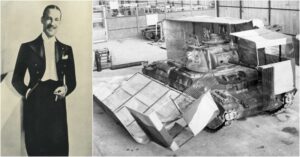During World War II, the fate of nations hinged on strategies and operations of immense complexity. Amidst the chaos and the desperate need for innovative deception techniques, an unlikely hero stepped forward. Jasper Maskelyne, a British magician, used his unparalleled skills in the art of illusion to deceive the enemy and protect crucial strategic targets. This article delves into the captivating story of Jasper Maskelyne, the renowned “War Magician,” and his unique contributions during one of the darkest chapters in human history.



Early Life and Magical Roots:
Born into a famous family of magicians in 1902, Jasper Maskelyne was exposed to the art of illusion from a young age. With an inherent talent and passion for magic, he performed alongside his family’s renowned Maskelyne and Devant’s act. This upbringing fused with his inventive mind and would later define his remarkable role during World War II.
Enlisting as a Military Illusionist:
When war broke out, Maskelyne’s services as a magician were uniquely sought after. He was enlisted by the British military due to his exceptional expertise in misdirection, concealment, and sleight of hand. Although unconventional, it quickly became apparent that his skills had extraordinary potential within the battlefield.
Protecting Strategic Targets:
Maskelyne’s primary objective was to protect strategic targets from enemy bombings and sabotage. One of his most notable achievements was the creation of “The Magic Gang,” a secretive group of illusionists who devised elaborate deceptions to confuse and divert enemy attention.
The Art of Camouflage:
Maskelyne revolutionized the art of camouflage by creating intricate decoys and hiding key installations using clever, handcrafted optical illusions. He built replica tanks, aircraft, and even entire military bases to draw attention away from genuine targets, ensuring that enemy attacks were focused on harmless distractions.
The Invisible Army:
One of Maskelyne’s most audacious ruses was the creation of the “Invisible Army.” He used vast amounts of mirrors and lights to make entire military units disappear before the enemy’s eyes. These elaborate illusions, along with sound effects, created the impression of an advancing army, leading the enemy to misdeploy their forces.
The El Alamein Deception:
Perhaps Maskelyne’s most famous achievement came during the critical Battle of El Alamein in 1942. At this stage, the British forces desperately needed a surprise advantage against the German Army. Maskelyne used his skills to hide the entire harbor of Alexandria, Egypt, from aerial reconnaissance by creating a realistic illusion of smoke and cloud cover, preventing German bombers from identifying the harbor’s importance.
Legacy and Controversies:
Despite his groundbreaking contributions, Maskelyne’s work remained classified for several decades after the war. The secrecy surrounding his achievements, as well as the absence of official records, led to numerous controversies and debates. Some questioned the accuracy of his claims, while others argued that Maskelyne’s efforts were grossly underappreciated.
Conclusion:
Jasper Maskelyne’s story is a testament to the extraordinary potential of ingenuity and deception during times of unprecedented global conflict. Through his remarkable illusionist skills, he protected vital strategic targets, saved countless lives, and played a crucial, if often overlooked, role in World War II.
Though the fog of war may have obscured some of the details surrounding his accomplishments, Jasper Maskelyne’s legacy as the War Magician endures. His unique abilities and unwavering dedication established deception as an integral part of modern warfare, ensuring that the world would never underestimate the power of illusion and misdirection again.
Here is an affiliate link for the book:

